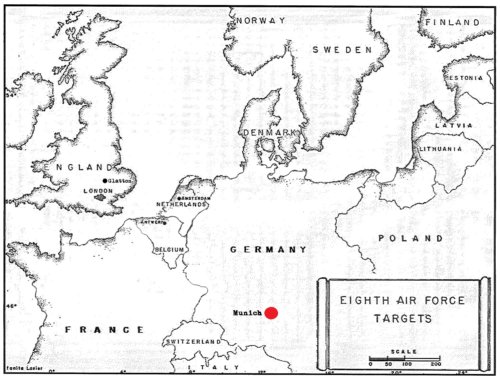TARGET: ALLACH AERO ENGINE WORKS
MUNICH, GERMANY
12 JULY, 1944

Heavy cloudy weather still persisted over all of enemy occupied Europe. Visual missions on strategic and tactical targets were impossible. Munich still remained the logical target for a PFF attack. Twelve hundred seventy Eighth Air Force heavies were dispatched in the operation on this hub of aerial and transportation activity. Again the 457th Group furnished thirty- six aircraft to form the lead and low boxes of the 94th B Combat Wing. Major Spencer led the Wing in a PFF plane, while Captain Reilly led the low box.
Takeoff was into a cloud filled sky. The penetration route was exactly the same as the mission the day before. Again French based enemy fighters chose to remain on the ground.
En route to Munich an occasional break in the clouds revealed landmarks on the ground. From the 1P, a normal run was made into the city with no malfunctions. When the flak belt around the city was pierced, the fire was more accurate than before.
Lt. Gerald L. Kerr’s plane fell back with No. 1 engine smoking and prop feathered, presumably a casualty to flak. The craft remained under control and later crashed into the Alps. Five of the crew survived.
The lead box released its bombs by PFF. A hole in the clouds revealed the Hadern suburbs to be directly below. Although clouds obscured the ground from that point, a plotting of the bomb fall placed them in the Ober Sendling industrial and residential district, three miles south of the center of Munich. The low box was unable to see the bombs released in the lead box and failed to drop. Accurate flak persisted as the formation crossed the area.
The Lt. Edward Kozel’s plane lost its No. 1 propeller and lagged behind the formation. No. 3 and No. 4 engines had low oil pressure. It headed for Switzerland and later landed there. Lt. Robert L. Kaufman’s plane was hit by flak, but made it back as far as the English Channel, where the crew bailed out, and all were picked up by Air/Sea Rescue.
After the force left Munich, a hole in the clouds revealed the small German town of Engstingen and the low box aimed its bombs at this target. They were scattered over a wide area. Eleven hundred fifty planes had attacked Munich.
Twenty-six airplanes were lost, eight of them went to Switzerland. Although it was impossible to determine the main impact of the bombs, photos were taken through the nine-tenths undercast, and indicated a bombing pattern in the center of the city, rather than in the outlying suburbs.
The following crews were lost on this date:
Lt Gerald L. Kerr
Lt Edward Kozel
Lt Robert L. Kaufman
